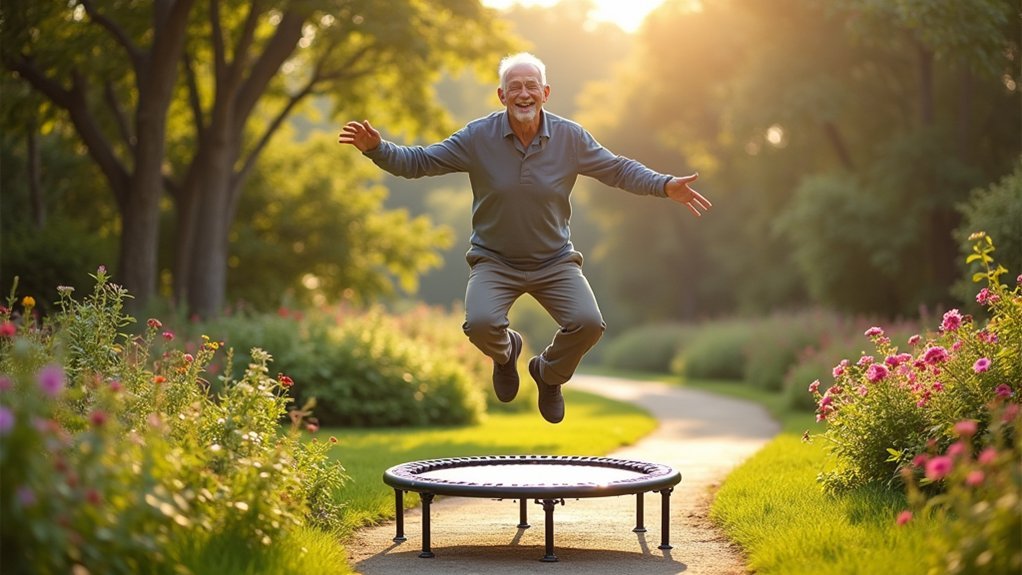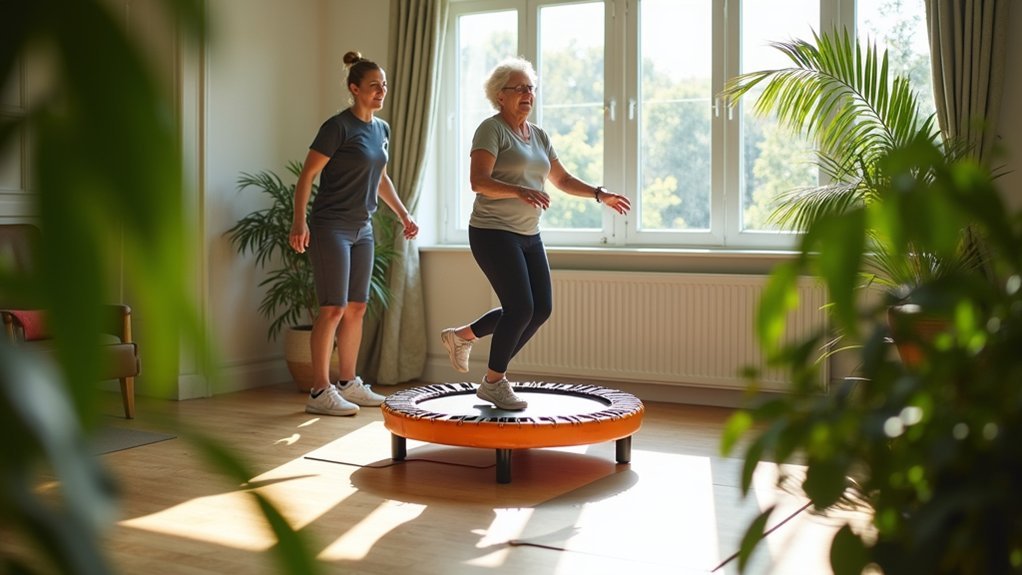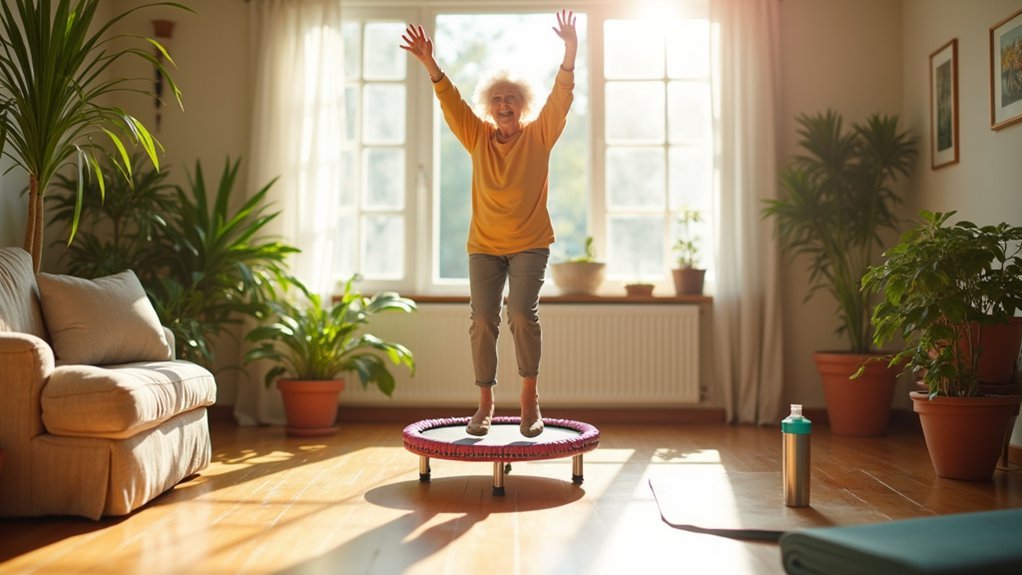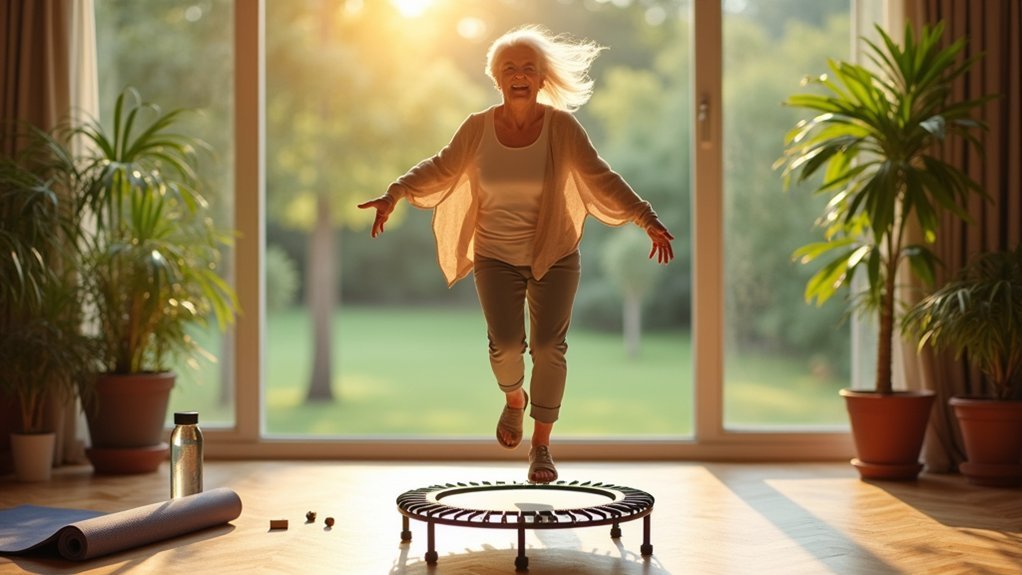Mini-trampolines effectively boost circulation after 60 by activating your cardiovascular system with less joint stress than walking. The gentle bouncing motion creates beneficial g-forces that enhance blood return to your heart, delivering more oxygen to tissues while stimulating lymphatic flow. You’ll experience reduced extremity swelling, increased energy, and improved sleep quality. Start with just 3-5 minutes daily using a stability bar for safety. Discover how this low-impact exercise can transform your circulatory health beyond what traditional exercises offer.
Understanding Circulatory Challenges After Age 60

As we cross the threshold of age 60, our circulatory system undergoes significant changes that can impact our overall health and quality of life.
You’ll notice your blood vessels becoming stiffer, causing higher systolic blood pressure and increased hypertension risk.
Your heart changes too—pacemaker cells in the sinoatrial node decrease, affecting heart rate regulation. The walls of your heart thicken as myocyte size increases while their number decreases.
Your arteries’ inner layers thicken, setting the stage for atherosclerosis. For women, this process accelerates significantly after menopause due to the loss of protective estrogen effects on cardiovascular health.
These transformations make you more vulnerable to heart attacks and atrial fibrillation. You might experience fatigue, cold hands and feet, leg cramps, or swelling.
Wounds heal more slowly as blood delivers oxygen and nutrients less efficiently. Understanding these changes is your first step toward managing circulatory health effectively.
The Science Behind Rebounding and Blood Flow
While the idea of bouncing on a mini-trampoline might seem like simple fun, this activity creates powerful physiological effects that can revolutionize your circulatory health.
Rebounding transforms simple bouncing into a circulatory revolution with every gravity-defying jump.
Each bounce creates a unique gravitational force that pushes blood through your vessels more efficiently than walking or running.
When you rebound, you’ll experience:
- Enhanced circulation – The constant changes in gravity pump blood throughout your body, especially improving flow in your legs.
- Increased oxygen delivery – Your cells receive more oxygen, boosting their efficiency and strength.
- Lymphatic system activation – Your immune system gets a boost through improved white blood cell circulation.
- Reduced impact forces – Unlike walking or jogging, rebounding’s elastic surface minimizes joint stress while maximizing cardiovascular benefits. The tension and release of muscles during rebounding significantly improves blood circulation throughout your entire body.
Safe Rebounding Techniques for Seniors

Despite its low-impact nature, rebounding requires proper technique for seniors to enjoy its circulatory benefits safely. Before beginning, verify your mini-trampoline sits on a flat surface and consider using a handlebar for added stability.
Start with a 3-5 minute warm-up followed by gentle stretches to prepare your body. Listen to your body and adjust intensity as needed. Maintaining proper core engagement throughout your rebounding session helps protect your lower back and improves overall stability.
| Exercise | Technique |
|---|---|
| Health Bounce | Stand with feet hip-width apart, bounce gently |
| Seated Bounce | Sit on rebounder, feet on floor, engage core |
| Marching | March in place to warm up muscles |
| Side-to-Side | Shift weight between feet to improve balance |
After rebounding, cool down with gentle stretches for your arms, legs, and back to prevent soreness. Remember to stay hydrated throughout your session.
Comparing Rebounding to Walking for Circulation
Many seniors wonder whether rebounding truly offers circulation benefits beyond their daily walks. Research suggests mini-trampoline exercise creates unique cardiovascular advantages through its vertical motion and gravitational forces.
Four key circulation differences:
- G-force activation – Rebounding’s up-and-down movement enhances blood return to your heart more effectively than walking’s horizontal motion.
- Oxygen demand – You’ll use more oxygen during rebounding than walking at similar perceived exertion levels.
- Lymphatic stimulation – The vertical bouncing mechanically pumps your lymphatic system, aiding toxin removal more efficiently.
- Caloric efficiency – You’ll burn 5-8 calories/minute rebounding versus 3-5 walking, due to greater full-body muscle engagement.
While walking remains excellent exercise, rebounding’s unique gravitational effects may provide additional circulatory benefits, particularly for those with limited mobility. Recorded data shows that rebounding generated an average heart rate of 121 bpm, significantly higher than walking’s 69 bpm average.
Starting Your Mini-Trampoline Journey: First Steps

You’ll need proper safety equipment, including non-slip socks and a stable trampoline with handrails for your first rebounding sessions.
Start with gentle health bounces where your feet don’t leave the mat, gradually building confidence before attempting more dynamic movements. This low-impact workout is excellent for seniors and beginners while still providing effective cardiovascular benefits.
As your balance improves, you can increase your bounce height and workout duration, but always listen to your body and progress at a comfortable pace.
Safety Equipment Essentials
Every mini-trampoline journey begins with proper safety equipment, ensuring your rebounding sessions remain both effective and injury-free. When selecting your mini-trampoline, prioritize models with padded safety skirts that completely cover springs or bungee cords to eliminate pinch points and protect against accidental contact. Properly installed safety accessories significantly reduce injury risks while enhancing your overall mini-trampoline experience.
- Choose models with foam-padded frames to cushion any potential impact if you lose balance.
- Look for tear-resistant, UV-treated mats that won’t degrade with regular use.
- Confirm your mini-trampoline displays clear weight limits to prevent overloading.
- Consider models with handrails if you’re concerned about stability.
Don’t overlook anchoring systems for additional stability during more vigorous bouncing.
While mini-trampolines lack the height risks of full-sized versions, these safety features remain essential for preventing common injuries, especially for those over 60.
Beginner Bounce Techniques
Three essential techniques form the foundation of effective mini-trampoline workouts for beginners.
Start with the Health Bounce—a gentle, rhythmic movement with feet hip-width apart while engaging your core muscles. This foundational move improves circulation and warms up your muscles. For an additional challenge, use a small deflated ball between your inner thighs while pressing down into the mat.
Progress to Side-to-Side Bounces, shifting weight between feet to enhance your balance and coordination. If you have mobility concerns, try the Seated Bounce with your feet firmly on the floor.
Always maintain a slight bend in your knees to absorb impact properly.
Begin with short 5-10 minute sessions, gradually increasing duration as your comfort grows. Remember to breathe deeply throughout your routine, and start each session with a 3-5 minute warm-up to prepare your muscles for activity.
Gradual Intensity Progression
Starting a mini-trampoline routine with proper intensity levels will set the foundation for your long-term success.
You’ll want to begin with low-impact movements that don’t stress your joints while gradually building up your endurance and strength.
- Begin with basic marching for 5-10 minutes, focusing on maintaining balance and proper posture. Incorporating slight knee bends during marching helps maintain proper form while reducing impact.
- Progress to alternating stepping patterns (side-to-side, forward-back) once you’re comfortable with basic bouncing.
- Incorporate strength elements like gentle squats or arm extensions after 2-3 weeks of consistent practice.
- Extend your sessions gradually from 10 minutes to 20-30 minutes as your fitness improves.
Equipment Selection for Older Adults
When selecting a mini-trampoline, prioritize models with balance handles and non-slip surfaces to prevent falls as you build confidence.
Choose a size that fits your space while ensuring the rebounder can safely support your weight—most quality 40 to 48-inch models accommodate up to 250-270 pounds.
Look for a stable, wide-based frame that won’t wobble during use, allowing you to focus on your workout instead of worrying about tipping. For older adults concerned about joint impact, consider rebounders with bungee cords rather than springs, as they provide a quieter and gentler bounce experience.
Safety Features Matter
While many older adults enthusiastically embrace the health benefits of mini-trampolines, selecting equipment with proper safety features remains critical for injury prevention. Your rebounder should prioritize stability and support to protect joints while maximizing circulation benefits.
- Look for models with adjustable safety handlebars featuring padded grips that provide essential support during directional changes and help maintain balance as you progress.
- Choose bungee cord systems over springs for quieter, lower-impact workouts that reduce joint stress—ideal if you have arthritis or mobility concerns.
- Prioritize wider frames with non-slip surfaces and low-to-ground profiles that minimize fall risks while still delivering effective G-force stimulation.
- Verify weight capacity exceeds your needs (300+ lbs models available) and includes memory foam edge padding to protect against accidental frame contact. JumpSport Fitness Trampolines deliver a forgiving bounce perfect for seniors wanting to improve balance and coordination while reducing impact on joints.
Size and Stability Considerations
Selecting the right size and guaranteeing proper stability go hand-in-hand with safety features when choosing your mini-trampoline. For adults over 60, a diameter between 40-48 inches offers ample space for movement while maintaining stability during your workout. The 44-inch models are often preferred by older adults as they provide more workout area for safer exercise movements.
| Feature | Why It Matters | Best for 60+ |
|---|---|---|
| Diameter | Affects exercise variety | 40-48 inches |
| Tension | Controls bounce intensity | Firmer for beginners |
| Frame | Guarantees safety | Steel with warranty |
| Accessories | Enhances usability | Stability bar included |
Look for adjustable tension systems that allow you to customize resistance as your fitness improves. A robust frame supporting at least 250 pounds ensures durability and safety during use. Consider models with stability bars if you’re concerned about balance—they’ll provide confidence while you build strength and coordination.
Preventing Dizziness During Rebounding Sessions
Experiencing dizziness on a mini-trampoline can quickly transform an enjoyable workout into a safety hazard. To keep your rebounding sessions safe and effective, implement these precautions:
- Start gradually – Begin with just 3-5 minutes of gentle bouncing, then incrementally increase your time by 1-2 minutes weekly as your body adapts.
- Maintain proper form – Engage your core, keep knees slightly bent, and fix your gaze on a stationary object to help your vestibular system adjust.
- Optimize your setup – Use a stability bar if needed, place your rebounder on a flat surface, and wear supportive shoes with good grip.
- Cool down properly – Reduce intensity gradually before stopping, then sit for 1-2 minutes afterward to stabilize your blood pressure. Incorporating gentle High Bounce exercises can effectively support lymphatic circulation during your cool-down routine.
Progressive Rebounding Routines for Heart Health
As you become comfortable with basic rebounding, implementing structured, progressive routines can markedly enhance your cardiovascular benefits.
Start with a 5-7 minute low-bounce warm-up to prepare your body for more intense activity.
Gradually increase your bouncing intensity to challenge your heart and promote better circulation.
Try incorporating interval training by alternating between high and low-intensity bounces – this effectively boosts your cardiovascular response without overexertion.
Add balance exercises to your routine to improve stability while simultaneously engaging your core muscles, which supports better heart function. This gentle form of exercise is ideal for seniors as it provides a low-impact workout while still delivering significant cardiovascular benefits.
This proprioceptive training not only improves circulation but also strengthens muscles that contribute to overall cardiovascular health.
Always finish your session with a slow, deliberate cool-down to prevent dizziness and reduce stress on your body.
Balance Support Options for New Rebounders
While many new rebounding enthusiasts feel uncertain about their balance during initial sessions, several support options can dramatically improve both safety and confidence. Mini-trampolines with safety rails provide essential stability as you learn proper technique, preventing falls and building trust in your movements.
- Start with a safety rail – These attachments offer something to hold onto while you develop your rebounding skills.
- Focus on core engagement – Exercises like marching in place strengthen your center and improve stability.
- Progress gradually – Begin with simple movements before advancing to more challenging routines.
- Consider professional guidance – A fitness instructor can teach proper form and recommend tailored balance exercises for your needs.
Regular mini-trampoline exercises can help seniors improve balance by approximately 35% after just 14 weeks of consistent practice.
Don’t let balance concerns keep you from enjoying the circulation-boosting benefits of rebounding!
Monitoring Your Circulatory Improvements
You’ll notice improved circulation from your mini-trampoline workouts by checking peripheral perfusion through simple tests like capillary refill in your fingertips.
Compare measurements before and after rebounding sessions to track how your blood flow changes over time.
Smart wearables that monitor heart rate and blood oxygen levels can provide valuable data on your circulatory improvements without requiring medical visits.
Consistent rebounding workouts strengthen your cardiovascular system and can lead to lower blood pressure, which is directly related to improved circulation throughout your body.
Tracking Peripheral Perfusion
Measuring the progress of your circulatory health offers tangible evidence that mini-trampoline workouts are improving your blood flow.
You can monitor peripheral perfusion—how well blood circulates to your extremities—using simple methods at home.
1. Check your capillary refill time by pressing a fingertip until it blanches, then timing how quickly color returns—faster times indicate better circulation.
2. Observe skin temperature gradients between your torso and extremities—smaller differences suggest improved blood flow.
3. Note skin appearance changes like reduced mottling or improved color as circulation improves.
This regular monitoring is particularly valuable since peripheral organs are the first to show hypoperfusion during circulatory compromise and the last to recover when circulation improves.
4. Consider optical monitoring devices that use reflected or transmitted light technology to provide objective measurements of your peripheral blood flow.
These non-invasive tracking methods help you confirm the circulatory benefits of your rebounding routine without invasive procedures.
Pre/Post Exercise Measurements
Moving from general tracking methods to structured measurement protocols gives you a more systematic way to verify your mini-trampoline workout benefits.
Before starting, record your resting heart rate, blood pressure, and oxygen saturation as your baseline values.
After each session, immediately check these same metrics to observe acute circulatory improvements.
Compare these readings over time—you’ll likely notice your resting heart rate decreasing and recovery time improving as your cardiovascular system strengthens.
Don’t forget to document your perceived exertion and any symptoms like reduced swelling or improved energy levels.
These subjective measures complement your objective data. A pulse oximeter and blood pressure monitor are essential tools for this tracking process.
This gentle rebounding exercise is particularly suitable for those over 60 as it remains easier on joints compared to high-impact activities.
This before-and-after approach helps you quantify progress and adjust your routine for best circulatory benefits as your fitness improves.
Smart Wearables Matter
Beyond traditional methods, smart wearables have revolutionized how we track circulatory improvements from mini-trampoline workouts. These devices provide continuous monitoring that captures real-time changes in your cardiovascular system during and after rebounding sessions.
Modern smartwatches and fitness trackers offer:
- PPG and ECG technology that detects blood volume changes and heart rhythms, giving you immediate feedback on workout effectiveness.
- Blood oxygen sensors that measure how efficiently your body utilizes oxygen during rebounding exercises.
- Real-time alerts for irregular heartbeats or blood pressure spikes that require attention.
- Long-term trend analysis to document your progress and identify subtle improvements in circulation over weeks of consistent trampoline use.
Your wearable becomes a personal health assistant, connecting with medical providers and enabling data-driven decisions about your rebounding routine. With hypertension affecting 1.3 billion people globally, these tracking capabilities become even more crucial for monitoring the cardiovascular benefits of your mini-trampoline workouts.
Rebounding for Medication-Related Circulation Issues
While many medications effectively manage chronic conditions, they often come with unwelcome side effects that impact circulation. Rebounding provides a gentle yet effective solution to these challenges.
The rhythmic bouncing on a mini-trampoline creates alternating gravitational forces that combat medication-induced venous stasis. This low-impact activity stimulates blood vessel walls, enhancing arterial elasticity that may counteract vascular stiffness from medications. Regular rebounding sessions can triple white blood cells, creating a stronger immune response to support overall circulatory health.
If you’re taking antihypertensives, monitor your blood pressure during sessions. Those on anticoagulants should guarantee proper padding, while diuretic users need to hydrate thoroughly before and after rebounding.
The benefits are impressive: improved oxygen delivery, enhanced lymphatic drainage, and reduced blood pooling—all essential if you’re managing conditions like hypertension, diabetes, or lymphedema with medications that compromise circulation.
Mini-Trampoline Exercises for Cold Hands and Feet
You’ll find surprising relief from cold extremities through strategic mini-trampoline movements that activate sluggish circulation.
Consistent rebounding enhances blood flow to your hands and feet through low-impact exercises like toe lifts, arm circles, and hand squeezes performed mid-bounce.
These gentle circulation boosters work especially well when you synchronize deep breathing with your rebounds—inhaling on the ascent and exhaling on descent to maximize oxygen delivery to your cold tissues. Regular mini-trampoline sessions stimulate lymphatic flow and support the body’s natural detoxification processes.
Gentle Circulation Boosters
Those who struggle with perpetually cold hands and feet can find relief through specialized mini-trampoline exercises designed to improve peripheral circulation.
These gentle rebounding movements stimulate blood flow to your extremities without stressing your joints.
- Basic bounce and arm pumps: Combine light, controlled vertical bounces with rhythmic arm raises to synchronize upper-body circulation with rebounds.
- Ankle circles: While gently bouncing, rotate your ankles in both directions to enhance blood flow to your feet.
- Side-to-side sway: Shift your weight laterally to engage core and lower body muscles, promoting circulation throughout your extremities.
- Seated bounce: If balance is a concern, perform gentle bounces while seated with periodic foot dorsiflexion to target cold extremities. These modifications provide low-impact options for those with mobility limitations or balance issues.
For best results, start with 5-minute sessions and gradually increase duration by 2 minutes weekly.
Peripheral Blood Flow Tricks
Three powerful mini-trampoline exercises specifically target circulation in cold hands and feet by combining gentle bouncing with strategic movement patterns.
While you bounce gently, try circling your arms outward to increase blood flow to your fingertips. This engages multiple muscle groups while enhancing peripheral circulation.
For cold feet, incorporate heel lifts during your bouncing session. Simply rise onto your toes with each bounce, activating calf muscles that pump blood back up from your lower extremities. This low-impact movement improves circulation without stressing your joints. The low-impact exercise is particularly beneficial for seniors with joint concerns.
Finally, try alternating between fast and slow bounces while wiggling your fingers and toes. This variation creates a pumping effect that supports lymphatic drainage and increases oxygen delivery to your extremities.
The gentle rebounding motion is 68% more efficient than running while providing similar circulatory benefits.
Extremity Warming Techniques
Mini-trampoline exercises for cold extremities begin with essential warm-up routines that prepare the body for improved circulation.
Start with low-impact bounces and seated marches to gradually activate blood flow to your hands and feet before progressing to more targeted movements. These gentle exercises are gentle on joints while effectively stimulating blood circulation throughout your extremities.
- Combine heel-toe lifts with arm swings to simultaneously engage both upper and lower extremities, maximizing circulation benefits.
- Alternate between handlebar grip variations during your bounce routine to stimulate blood flow through your palms and fingers.
- Incorporate single-leg balance bounces with overhead arm pumps to challenge your stability while fighting gravitational blood pooling.
- End with a progressive cool-down that includes gradual bounce reduction and controlled breathing to prevent blood pressure drops while maintaining warmth.
Combining Rebounding With Other Circulation Boosters
While rebounding alone offers significant circulation benefits, combining mini-trampoline exercises with complementary lifestyle practices can amplify your results.
Enhance these effects by incorporating omega-3 rich foods like fish and nuts, along with antioxidant-packed berries and leafy greens.
Stay well-hydrated and consider adding spicy foods containing circulation-boosting capsaicin to your diet. Reduce sodium intake to support healthy blood pressure levels alongside your rebounding routine.
For maximum benefit, pair your trampoline sessions with other gentle exercises. Rebounding significantly prevents blood clots through its gentle bouncing motion that keeps blood flowing efficiently throughout the body.
Try strength training to increase muscle blood flow, yoga for flexibility, swimming or walking for additional cardiovascular support. These combinations create a thorough approach to improving circulation, maximizing the health benefits you’ll experience from your rebounding practice.
Success Stories: Seniors Who Transformed Their Circulation
Across the country, countless seniors have discovered remarkable improvements in their circulatory health through regular rebounding. One 68-year-old man achieved significant weight loss and renewed physical activity, transforming his vascular health through consistent mini-trampoline sessions.
Beyond weight management, seniors report:
- Reduced swelling in extremities and increased energy levels, clear indicators of improved vascular function
- Enhanced sleep quality, often resulting from optimized blood flow throughout the body
- Decreased joint stiffness and improved mobility, enabling more consistent circulation-boosting activity
- 35% improvement in balance recovery after 14 weeks, contributing to safer, more active lifestyles
These testimonials highlight rebounding’s unique ability to deliver cardiovascular benefits without the joint stress of traditional exercise—perfect for aging bodies seeking circulatory renewal. Many seniors find rebounding especially beneficial as it promotes lymphatic flushing, which helps remove toxins and improves overall circulation.
Frequently Asked Questions
Can Rebounding Help With Medication-Induced Peripheral Edema?
Yes, rebounding can help reduce medication-induced peripheral edema. The gentle bouncing motion stimulates your lymphatic system, improving fluid drainage. You’ll experience better circulation as the pumping action helps move excess fluid from your extremities.
How Does Rebounding Affect Blood Pressure Immediately After a Session?
Immediately after rebounding, you’ll likely experience decreased blood pressure as your blood vessels remain dilated. This post-exercise hypotension typically occurs within 30-60 minutes of your session, with potential drops of 7-15 mmHg systolic.
Can Mini-Trampolines Be Used Effectively With Mobility Devices?
Yes, you can use mini-trampolines effectively with mobility devices when you select models with sturdy frames, add stabilizers or support handles, and make certain they accommodate your weight requirements. Always consult healthcare professionals for personalized guidance.
Does Altitude Affect the Circulatory Benefits of Rebounding?
Yes, altitude does affect rebounding’s circulatory benefits. At higher elevations, you’ll experience increased cardiovascular stress due to lower oxygen levels, potentially amplifying both the challenges and blood flow benefits of your rebounding workouts.
Will Rebounding Interfere With Pacemakers or Other Cardiac Devices?
Rebounding may pose risks with your pacemaker due to potential electromagnetic interference. You’ll need explicit approval from your cardiologist before starting. Wait at least one month post-implantation when leads have stabilized before considering this activity.
In Summary
You’ve just discovered a powerful tool for revitalizing your circulation after 60. Mini-trampolines offer a gentle, effective way to boost blood flow throughout your body without stressing your joints. Start slowly, stay consistent, and you’ll likely notice warmer extremities, improved energy, and better overall health. Whether you’re managing medication side effects or simply fighting the natural aging process, you’re now equipped to bounce your way to better circulation.





Leave a Reply